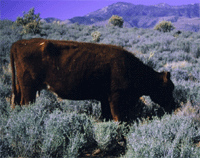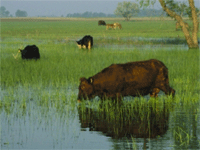
The terrain in Utah (above) creates a much different cow than those in Louisiana |

|
Origins of Preference
While we are used to considering forage type, nutrition and quantity as we try to improve animal health and increase weight gain, we sometimes overlook how an animal's interactions with it's mother and peers affect what and how it eats. Since what a young animal learns has life-long consequences, knowing more about this process can help us be more successful managers.
A young animal learns what kind of things it should eat and do from its herd or "social group." This explains how animals of the same species can survive in extremely different environments. For example, a calf reared in the sage-covered deserts of southern Utah and one raised on grass in the bayous of Lousiana have completely different diets and habits. This same flexibility occurs for humans as psychologist Paul Rozin points out: "Consider the massive differences between the almost purely carnivorous diet of Eskimos and the plant-dominated diets of many tropical cultures, or between the elaborate cuisines of India or France and the relatively limited amounts of food processing carried out by some hunter-gatherers."
Next - Listen to Your Mother!
|

